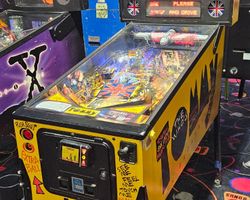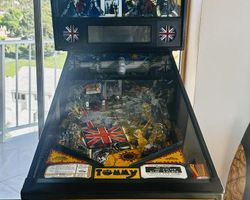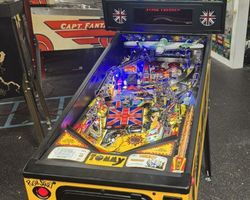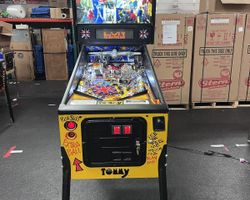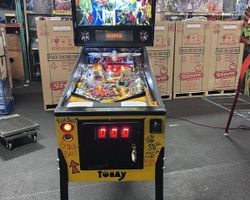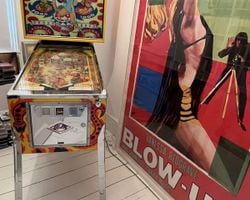The Who's Tommy Pinball Wizard
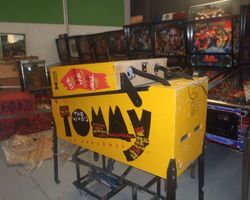
Average Prices: USD $1,100 to $3,700
Produced: January, 1994
Production Run: 3,500 units
Machine Type: Solid State Electronic
MPU: DataEast/Sega Version 3
Players: 4
Design by: Ed Cebula, Joe Kaminkow, Lyman F. Sheats Jr., Lonnie D. Ropp
Art by: Kurt Andersen, Markus Rothkranz
Dots/Animation by: Kurt Andersen, Jack Liddon
Music by: Brian Schmidt
Sound by: Brian Schmidt
Software by: John Carpenter, Lyman F. Sheats Jr., Lonnie D. Ropp
Data East's "The Who's Tommy Pinball Wizard," released in February 1994, brought the spectacle of the renowned rock opera to the pinball arena. This solid-state electronic machine, model 500-5528-01, was a significant licensed theme for Data East, drawing directly from the theatrical production of "Tommy." The inspiration was clear: translate the narrative and musical energy of the stage show into a compelling pinball experience, inviting players to "See it, feel it, touch it, play it, BUY IT!" or simply engage with a game where "Tommy, a name that means pinball," defines the experience.
The design and production of this pinball machine involved a collaborative effort from notable individuals in the industry. The core design team consisted of Ed Cebula, Joe Kaminkow, Lonnie D. Ropp, and Lyman F. Sheats Jr., who conceptualized how the "Tommy" narrative could unfold across a pinball playfield. Kurt Andersen and Markus Rothkranz were responsible for the distinct artwork, bringing the visual flair of the theme to life on the cabinet and playfield. Brian Schmidt composed the custom music and sounds, integral to capturing the essence of the rock opera, with vocals by Michael Cerveris. The complex software that governed the machine's intricate modes and reactions was developed by John Carpenter, Lonnie D. Ropp, and Lyman F. Sheats Jr., while Jack Liddon and Kurt Andersen handled the animation displayed on the dot matrix screen.
Production of "The Who's Tommy Pinball Wizard" ran from January 8, 1994, to April 9, 1994, with 4,700 units confirmed. Before full production, ten pre-production prototypes were created for promotional use, coinciding with the off-Broadway theatrical productions. These early versions featured six pop bumpers, a contrast to the three found in the production models. One prototype famously debuted at the Hard Rock Cafe in Dallas in October 1993 but was unfortunately damaged in transit. Another special prototype, rigged for "autoplay" and lacking a backbox with electronics housed in the cabinet, was featured in the 1993 Macy's Thanksgiving Day Parade. These prototypes often had unique identifiers, such as a "P" on the white airplane toy, bare metal habitrails instead of chromed ones, and specific playfield details like the "Acid Queen" inserts and an early Union Jack design. Even the production games saw variations, with different paint schemes around the VUK (Vertical Up-Kicker) hole on the playfield.
Signature Features and Design
"The Who's Tommy Pinball Wizard" is distinguished by several unique features that deeply integrate with its thematic core and enhance the player experience. Foremost among these are the innovative flipper blinders. These extend from beneath the metal apron, obscuring the player's view of the flipper area. This mechanism is crucial for the "Tommy Scoring" mode, forcing players to truly play "blind as Tommy," relying on sound cues and muscle memory rather than direct sight. This feature is not merely a gimmick but a direct interpretation of the source material, creating a moment of genuine immersion and challenge.
Another prominent toy is Captain Walker's airplane, located on the upper playfield. This static toy plays a central role in the machine's video mode, where players pilot the plane on the dot matrix display. A raising and lowering mirror on the playfield serves as an interactive element, altering shot trajectories and adding a layer of unpredictability and strategy to the game. Perched atop the backbox is a striking silver ball, reminiscent of a bowling ball, serving as an eye-catching visual cue. The machine features three flippers, three pop bumpers, and supports an impressive six-ball multiball, adding to the high-energy gameplay. The inclusion of custom speech and a dot matrix display further enriches the narrative and feedback during play.
Playfield and Mechanics
The playfield of "The Who's Tommy Pinball Wizard" is a vibrant tableau, visually arresting with its bright, energetic artwork by Kurt Andersen and Markus Rothkranz. The main design elements, including the Union Jack motif, immediately establish the British rock opera setting. The layout features two ramps that guide shots across the playfield, complemented by three pop bumpers that create dynamic ball action in the upper section. A central captive ball offers a repeatable target for scoring and mode progression.
The playfield layout is designed for flow and engagement, encouraging players to hit various shots to advance through the game's story. Major shots include ramp entries, target banks, and the VUK hole, which often serves as an entry point to different game modes. The lighting is strategically implemented, illuminating key shots and guiding the player's focus towards active objectives. The overall aesthetic of the playfield is meticulously crafted to evoke the visual style of "Tommy," immersing players in the world of the rock opera. The precise placement of elements like Captain Walker's airplane and the raising mirror is not just for decoration but is integral to the machine's gameplay mechanics, enhancing both visual appeal and strategic depth. The manual and automatic plunger provides options for varied skill shots at the game's outset.
Gameplay Dynamics
The gameplay of "The Who's Tommy Pinball Wizard" is built around a comprehensive rule set that rewards players for exploring its numerous modes and objectives. The progression system is deeply tied to the "Tommy" narrative, with each major objective leading the player further into the story. The scoring system is designed to reward successful completion of modes, multi-ball sequences, and strategic shot selection.
A standout gameplay mechanic is the "Tommy Scoring" mode, where the aforementioned flipper blinders activate, challenging players to play without seeing their flippers. This mode exemplifies the machine's commitment to theme integration, directly translating Tommy's "blindness" into a pinball challenge. For those seeking an ultimate test, an operator option allows for a "Tommy Shield Game," where pressing the extra ball button along with the start button keeps the blinders active for the entire game.
The machine also features a captivating video mode, where players use the flipper buttons to steer Captain Walker's airplane on the dot matrix display, dropping bombs on buildings and shooting enemy planes. This provides a distinct change of pace from traditional playfield action. Six-ball multiball is a core attraction, offering a high-energy, high-scoring opportunity that many players find exhilarating. The game features a variety of modes and storylines, each accompanied by distinct music and objectives, ensuring that gameplay remains fresh and engaging across multiple sessions. These modes often require hitting specific shots or combinations, encouraging players to learn the playfield layout and develop strategies to maximize their scores. Operators could also configure the machine for unlimited buy-in balls per player, offering extended gameplay opportunities.
Reception and Legacy
"The Who's Tommy Pinball Wizard" has garnered significant positive reception within the pinball community, frequently cited as one of Data East's best achievements. Its overall sentiment is highly favorable, with many enthusiasts considering it a "keeper" for their collections due to its engaging nature.
The machine's gameplay is consistently praised as fun, challenging, and addictive, drawing players back for repeated sessions. Its flow is highlighted as excellent, featuring smooth shots and a wide array of targets. The multiball modes, particularly the six-ball multiball, are highly regarded for their excitement and challenge. Unique features like the flipper blinders, the raising mirror, Captain Walker's airplane, and the skill shot are frequently mentioned as standout elements that set this machine apart. The game's numerous modes and well-integrated storylines, each with unique music and objectives, contribute to its depth and variety. The rule set is generally considered robust and rewarding, offering layers of strategy for dedicated players.
The theme integration is a significant strength, faithfully translating the essence of the rock opera and Broadway play into pinball form. The music, derived from the Broadway rendition of "Tommy," is a major draw, widely lauded as fantastic, though some players express a preference for The Who's original recordings. Aesthetically, the playfield art is often commended for its brightness and vibrant colors, and the cabinet artwork is also seen as well-executed. Many owners have enhanced their experience with upgrades such as color DMDs and LED lighting, which are reported to further improve the game's visual appeal.
However, the machine is not without its areas for improvement. A common critique revolves around the sound quality, which, despite the excellent music, is sometimes perceived as low fidelity. Some players express disappointment that the soundtrack uses the Broadway production's music rather than The Who's original recordings. While the playfield art is largely beloved, a few individuals find aspects of the cabinet or backglass artwork less appealing. From a gameplay perspective, some players describe the game as difficult, noting that the outlanes can be punishing. Certain shots can occasionally feel "clunky," leading to rejects. Additionally, some find specific callouts to be repetitive over extended play. Like many machines of its era, "Tommy" can also exhibit reliability issues, requiring maintenance from time to time.
Despite these minor drawbacks, "The Who's Tommy Pinball Wizard" maintains a strong legacy. It is widely regarded as a significant achievement for Data East, showcasing their ability to integrate a rich, complex theme with innovative pinball mechanics. Its unique blend of challenging gameplay, thematic immersion, and memorable features has cemented its reputation as a highly sought-after and enjoyable pinball machine in the community.
Sponsored Links
 Ebay Listings
Ebay Listings
 Auction Results
Auction Results
| Cost | Location | Date |
|---|---|---|
| USD $4,500 |  United States United States |
19 November, 2025 |
| USD $3,650 |  Pennsylvania, United States Pennsylvania, United States |
14 September, 2025 |
| USD $5,495 |  Texas, United States Texas, United States |
09 August, 2025 |
| USD $4,800 |  California, United States California, United States |
04 August, 2025 |
| USD $4,900 |  Minnesota, United States Minnesota, United States |
21 May, 2025 |
| USD $5,489 |  Florida, United States Florida, United States |
24 February, 2025 |
| USD $5,489 |  Florida, United States Florida, United States |
22 January, 2025 |
| USD $4,999 |  Florida, United States Florida, United States |
04 January, 2025 |
| EUR €3,500 |  Hessen, Germany Hessen, Germany |
23 December, 2024 |
| EUR €3,500 |  Hessen, Germany Hessen, Germany |
11 December, 2024 |


Private Policy · Search Website · Contact Us
As an eBay Partner, we may earn a commission from qualifying purchases made through links on this site, at no additional cost to you.
All trademarks and copyrighted materials remain property of their respective owners. All other content copyright 2007 - 2025 Pinpedia.

